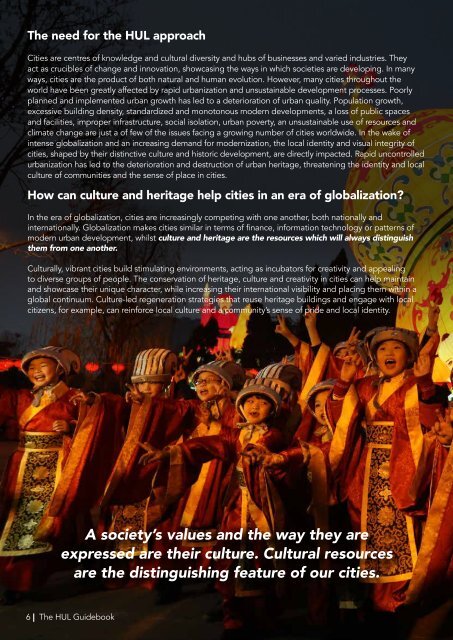GUIDEBOOK
wirey5prpznidqx
wirey5prpznidqx
Create successful ePaper yourself
Turn your PDF publications into a flip-book with our unique Google optimized e-Paper software.
The need for the HUL approach<br />
Cities are centres of knowledge and cultural diversity and hubs of businesses and varied industries. They<br />
act as crucibles of change and innovation, showcasing the ways in which societies are developing. In many<br />
ways, cities are the product of both natural and human evolution. However, many cities throughout the<br />
world have been greatly affected by rapid urbanization and unsustainable development processes. Poorly<br />
planned and implemented urban growth has led to a deterioration of urban quality. Population growth,<br />
excessive building density, standardized and monotonous modern developments, a loss of public spaces<br />
and facilities, improper infrastructure, social isolation, urban poverty, an unsustainable use of resources and<br />
climate change are just a of few of the issues facing a growing number of cities worldwide. In the wake of<br />
intense globalization and an increasing demand for modernization, the local identity and visual integrity of<br />
cities, shaped by their distinctive culture and historic development, are directly impacted. Rapid uncontrolled<br />
urbanization has led to the deterioration and destruction of urban heritage, threatening the identity and local<br />
culture of communities and the sense of place in cities.<br />
How can culture and heritage help cities in an era of globalization?<br />
In the era of globalization, cities are increasingly competing with one another, both nationally and<br />
internationally. Globalization makes cities similar in terms of finance, information technology or patterns of<br />
modern urban development, whilst culture and heritage are the resources which will always distinguish<br />
them from one another.<br />
Culturally, vibrant cities build stimulating environments, acting as incubators for creativity and appealing<br />
to diverse groups of people. The conservation of heritage, culture and creativity in cities can help maintain<br />
and showcase their unique character, while increasing their international visibility and placing them within a<br />
global continuum. Culture-led regeneration strategies that reuse heritage buildings and engage with local<br />
citizens, for example, can reinforce local culture and a community’s sense of pride and local identity.<br />
A society’s values and the way they are<br />
expressed are their culture. Cultural resources<br />
are the distinguishing feature of our cities.<br />
6 | The HUL Guidebook


